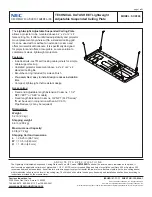
WOP-2ac-LR2. User manual
26
•
•
•
•
•
•
•
•
•
•
•
•
•
•
•
•
•
•
•
•
•
•
•
Voltage
– SFP module supply voltage;
Current
– SFP module laser bias current;
Emission power
– transceiver output power;
Receiver power
– receiver input power.
ARP
The ARP table contains information about the alignment between the IP and MAC addresses of neighboring
network devices:
IP address
– device IP address;
MAC
– device MAC address.
Routes:
Interface
– name of the bridge interface;
Destination
– IP address of destination host or subnet that the route is established to;
Gateway
– gateway IP address that allows for the access to the Destination.
Netmask
– subnet mask;
Flags
– certain route characteristics. The following flag values exist:
U
– means that the route is created and passable;
H
– identifies the route to the specific host;
G
– means that the route lies through the external gateway; System network interface provides
routes in the network with direct connection. All other routes lie through the external gateways. G
flag is used for all routes except for the routes in the direct connection networks.
R
– indicates that the route was most likely created by a dynamic routing protocol running on the
local system using the reinstate parameter;
D
– indicates that the route was added as a result of receiving an ICMP Redirect Message. When
the system learns the route from the ICMP Redirect message, the route will be added into the
routing table in order to exclude redirection of the following packets intended for the same
destination.
М
– means that the route was modified – likely by a dynamic routing protocol running on a local
system with the 'mod' parameter applied;
А
- points to a buffered route to which an entry in the ARP table corresponds.
С
– means that the route source is the core routing buffer;
L
- indicates that the destination of the route is one of the addresses of this computer. Such 'local
routes' exist in the routing buffer only.
В
– means that the route destination is a broadcasting address. Such 'broadcast routes' exist in
the routing buffer only.
I
– indicates that the route is connected to a ring (loopback) interface for a purpose other than to
access the ring network. Such 'internal routes' exist in the routing buffer only.
!
– means that datagrams sent to this address will be rejected by the system.
















































